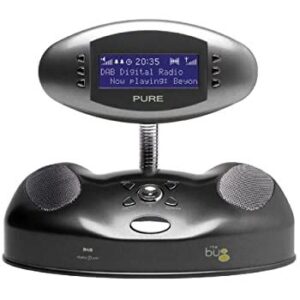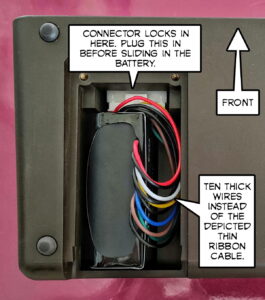Britain has pioneered many new technologies, created new markets, but—in the last century and this—has typically failed to follow through. The brand name “Pure” tells this whole story in miniature.
At the end of the last century a high tech company appropriately called Imagination Technologies emerged from a pioneering UK manufacturer of graphics and audio systems previously known as Videologic. The new name was inspired by its strategic decision to pull out of loss-making physical production and focus on licencing intellectual property. In the light of this successful strategy, the Videologic brand was renamed Pure Digital, marking the company’s new policy of sticking to design and leaving the manufacturing to others.
In the early years of the 21st century, Pure pioneered new processors for the burgeoning market in DAB (Digital Audio Broadcast) radios. As proof of concept the company manufactured a radio, the Evoke 1. It was the first DAB radio to sell for under £100.
And sell it did. Contrary to its IP-only strategy, Pure found itself in the manufacturing business. Pure branded radios lead the way in the DAB market all through the first decade of this century, creating the first pocket DAB radio in 2003, followed the year after by the Bug, the first radio which could record, pause and rewind and came with its own electronic programming guide,.
The parent company, Imagination, was also on a winning streak, striking lucrative chip licencing deals with Apple, Qualcomm, Texas Instruments and others. But as the money rolled in, it also rolled out again in the form of acquisitions. Profitability peaked shortly after the first decade of the new century and in 2016 Imagination was looking for cost savings. And a new CEO and a buyer for its Pure division.
The purchaser was an Austrian designer, manufacturer and distributor of consumer electronics, AVenture AT, that trades under the name Aqipa.
More than five years later, Pure Digital remains at its old location in Kings Langley, UK, sharing that address with Aquipa. The once world-beating UK brand continues to evolve new offerings from there, although the origin statement on the Pure Evoke Play also includes Kundl, Austria as the company’s address. Unsurprisingly, the manufacturing is done in China.
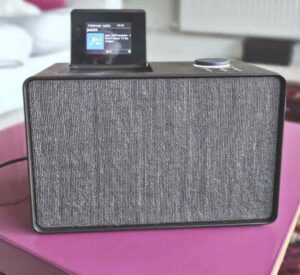 THE PURE EVOKE PLAY IS a very solidly built FM/DAB over-the-air and Internet radio that doubles as a Bluetooth speaker. It also adds Spotify, if you’re so inclined (we were not. But we delved in anyway, see below.). A recent firmware update has added Internet podcasts.
THE PURE EVOKE PLAY IS a very solidly built FM/DAB over-the-air and Internet radio that doubles as a Bluetooth speaker. It also adds Spotify, if you’re so inclined (we were not. But we delved in anyway, see below.). A recent firmware update has added Internet podcasts.
The radio is sold in two versions, Cotton White and Coffee Black. Our review model is the Coffee Black version, which in daylight reads more as a dark chocolate brown.
The industrial design raises some questions we’ll touch on later. But in daily use the Evoke Play does a fine job as a general purpose table radio. It’s the middle version of a new Pure Evoke range, between the smaller Evoke Spot and the wider Evoke Home.
The three radios are very similar in style, each featuring the same fold-out colour display, and their range of functions is largely the same. The Spot has room only for a single 3″ speaker. The Play expands the output to stereo by accommodating a pair of small tweeters on either side of the 3.5″ woofer that drives a fairly booming base reflex port (more on this below). The Home uses the same 3.5″ speaker and base reflex but takes advantage of the wider form-factor to improve the stereo soundscape by adding a second pair of small speakers. It also adds a CD player, if you’re still into that.
The Spot and the Home are mentioned here only to put the Play in context. We’ve had no experience of them—remarks here are confined to the Evoke Play, donated to Tested Technology for this review.
Spotify comes into its own, however, when you install the Spotify app on your phone. The app offers you the option of streaming directly across your LAN to the Evoke Play.
If you pay for a Spotify subscription (£10 monthly) you can double the stream quality to a very acceptable 320kbps.
Setting Up
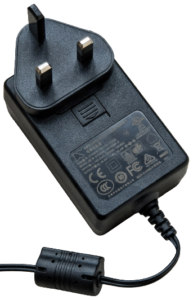 The Evoke Play comes with an external switching mode power supply that connects to the radio with a conventional barrel connector. An optional rechargeable battery is available as a cost option (see below).
The Evoke Play comes with an external switching mode power supply that connects to the radio with a conventional barrel connector. An optional rechargeable battery is available as a cost option (see below).
On first powering up and switching on by pressing the large, rim-illuminated volume button, you’ll need to open up the flip screen on the top surface, from which the firmware will take you through the setup sequence. This configures date and time settings and includes a conventional WiFi connection routine. You can use WPS for this or set up the link to your access point manually, which involves spelling out your password by steering through an alphabet list using the navigation keys in the well below the screen.
In case you might want to move the Evoke Play between different locations, the firmware can remember the passwords of up to four different SSIDs. If you need to diagnose network problems, the Main Menu/System Settings/Network provides useful information on parameters like the IP address allocated to the device and the SSID of the connected access point.
Sound Design
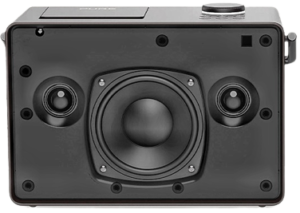
The Evoke Play’s speaker arrangement, normally invisible behind the non-removable cloth covering.
The Play does an excellent job of evoking (ha!) a very decent sound from a case the size of a smallish handbag. It’s not what we’d strictly call HiFi—as you might expect from the dimensions, the stereo separation is barely distinguishable at normal listening distance. And the tweeters and bass speakers sell the mid-range somewhat short.
Yes, these are minor niggles in the context of a device of this kind. We only mention this in the light of the marketing bumf, which claims that “the Evoke Play fulfils all your music needs”. If Pure had said that the Play does more or less full justice to the sources it’s able to pull in and that its bass reflex arrangement makes remarkably good use of the compact form-factor, there would be little to quarrel with, sound-wise.
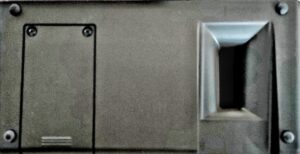
The bass reflex port from below. The screwed plate on the left houses the optional ChargePAK rechargeable battery.
That bass reflex port exhausts directly downwards into the thin airspace between the bottom of the Play and the surface supporting it, as defined by the device’s four shallow rubber feet. This has the rather important implication that the way the Play renders the bass frequencies is dependent on the surface the radio is standing on. If you’re finding the bass a touch too boomy, put it on a carpetted floor. If more woomf is what you need, a bare wooden table will help (marvellous for the Bach Cello Sonatas).
Those old-fashioned bass and treble knobs are long gone from radios like this. We miss them somewhat*.
Apropos fulfilling all your music needs, it seems odd that although the device connects to the Internet wirelessly via your LAN there’s no provision for playing audio media from your local PC or NAS. Clearly, the hardware to do this is incorporated in the Play—adding the feature with a firmware update would be trivial.
And why just Spotify? No Tidal, no Deezer. The design seems to leave room for these in subsequent firmware updates. But with more than 85,000 Internet radio stations and podcasts to choose from, you might feel you won’t miss a few dedicated music streaming services.
The Flip Screen and the Well
This strikes us as an odd design choice, but Pure has a history of this. The Bug, circa 2004 was an even more extreme departure from traditional radio set aesthetics.
It’s certainly useful to have a screen that tells you what’s playing. Switched to Internet Radio, for example, you’re shown the current mode, the time of day, the name of the station with its logo and—depending on the station—details of what’s currently being broadcast.
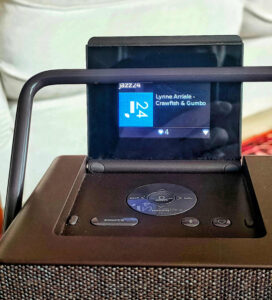
A larger screen that responded to touch might have been a more useful choice, perhaps simply embedded in the top surface. The non-touch screen Pure uses is very much smaller than the small flip lid, and so is surrounded by an outsize bezel. Instead of touch functions, the well that’s revealed when the lid is flipped open has an array of physical buttons.
The arrangement is quite usable once you’re familiar with it. One immediately obvious problem is that there’s no lighting for the array of push buttons in the well (a line of Source, Bluetooth and Favourite buttons below a four-way rocker switch for steering with a Select button in the centre).
In a discreetly lit room in the evening or during an early morning wake-up you need to be very familiar with the layout. The large volume button to the right of the well that also serves as a muting switch (short push) and a power switch (push and hold) has an illuminated ring round it. Something of this sort would have been helpful in the well.
The handle, running the full width of the device and normally living behind it, is a useful aid to portability. Once you start making use of the handle you’ll discover that it’s not designed to clear the flipped-up flip screen, which you’ll have to fold down first. Again, a rather curious design decision—adding an inch to the height of the handle would have solved this.
Pure was an early pioneer not just of DAB but also of the use of OLED displays—before the shortcomings of that display technology were properly understood.
The unfortunate consequence was that displays on many of its models produced early this century eventually faded and in many cases failed to light up altogether.
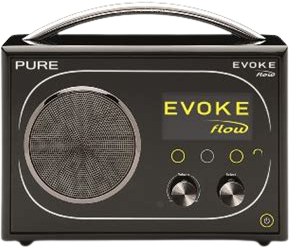 For example, the Pure Evoke Flow, launched in 2008 for £150 can be picked up on eBay today for less than £10—fully working except for the screen (which, of course, means the device is more or less unusable).
For example, the Pure Evoke Flow, launched in 2008 for £150 can be picked up on eBay today for less than £10—fully working except for the screen (which, of course, means the device is more or less unusable).
Tested Technology has one of these Evoke Flows with a failed screen and we expected Pure to be offering some sort of repair service. But apparently the failure rate has been overwhelmingly large (check the number of failed Flows currently on eBay) and Pure is not offering repairs at any price.
The TFT LCD technology now used in the Pure Evoke Play range obviates this problem.
Presets
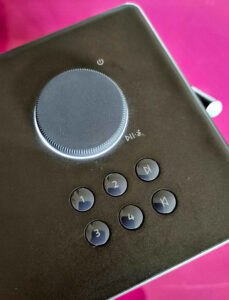 In addition to the buttons in the well, two rows of three buttons each immediately below the main Power/Volume knob make it easy to switch between preset stations. Six buttons in total doesn’t seem like a lot of presets. There are fewer, in fact, as only buttons 1-4 are numbered. The other two show left and right facing arrows and are used for scanning between stations.
In addition to the buttons in the well, two rows of three buttons each immediately below the main Power/Volume knob make it easy to switch between preset stations. Six buttons in total doesn’t seem like a lot of presets. There are fewer, in fact, as only buttons 1-4 are numbered. The other two show left and right facing arrows and are used for scanning between stations.
Setting any of these four buttons to a preset simply requires tuning to the station and pressing and holding the required preset button until the message “Preset stored” appears on the screen.
Only four preset buttons. But in fact the choice is much larger.
Not that there’s any easy way to discover how to store presets higher than four. The manual only says: “PRESETS: Long press a preset button to save your favourite station as a preset. Short press a preset button to recall either preset.” Not a word about storing presets higher than the number 4, for which there is no button.
Confusing. Press the Favorites button in the well (when the input is other than Bluetooth) and you’ll see a list of available presets to restore. The list is headed “Recall from Preset” and includes available empty presets. But there is no clue as to how to fill any of those empty presets.
The secret, which Pure seems to want to keep close to its chest, lies with that button. A short press brings up the list of recallable presets; a long press offers the same list but this time with the heading “Save to Preset”. With the arrow keys on the button in the central well you navigate down to an available empty preset and you’re done.
The list shows only ten presets. But this is per input function: ten presets for each of the possible inputs other than Bluetooth.
Bluetooth
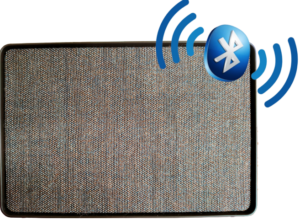
The latest revision of the Bluetooth standard, version 5.2, was launched in January 2020. It brings some radical improvements and additional functions that you can read about here. The version of Bluetooth used in the Evoke Play is listed in the official specs as 4.2. It’s a surprise that a premium audio device launched in late 2021 is limited to a Bluetooth standard that’s eight years old and two versions behind the latest implementation.
Having said that, Bluetooth 4.2 is adequate for most of what the Evoke Play needs to do. Here at Tested Technology Towers this is mainly connecting to our phones for playing tracks from our QNAP NAS. Relaying the music over Bluetooth to the Evoke Play like this is a work-around for the previously mentioned missing Evoke function of playing direct from the NAS.
In this manner the Evoke Play operates as a (rather superior) Bluetooth speaker. What the radio can’t do, sadly, is transmit to Bluetooth headphones. In fact, a curious shortcoming of the Evoke Play is that it offers no way at all of listening privately on headphones, wired or wireless. The thinking may well be that now we all have phones, our private listening is already catered for.
DAB+ and FM
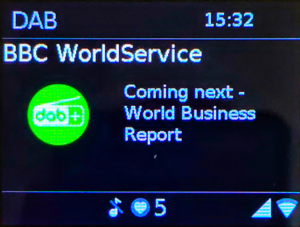
DAB (digital audio broadcasting) was introduced in the UK back in the mid 1990s and Pure became a powerful promotional force for it early in this century. The original DAB was based on a compression coding and decoding system (codec) called MP2, the forerunner of the familiar (and more efficient) MP3. DAB+ is a later development of DAB which uses an even more efficient codec, AAC+. “Efficiency” here means that a wider audio bandwidth can be packed into a narrower radio bandwidth.
You might think this implies that DAB+ provides better audio than DAB. Sadly, DAB’s track record in the UK has been to use advances in codec efficiency to squeeze more and more radio stations into any given bandwidth at the cost of quality.
The original promise of DAB was high fidelity audio without interference and the very first DAB broadcasts in the UK (test transmissions of birdcalls) employed a wide radio bandwith, providing excellent audio quality. As newer DAB radio stations crowded into the airways DAB quality fell alarmingly and many audiophiles preferred to return to FM transmissions to listen to concerts.
The additional efficiency of DAB+ hasn’t improved the audio picture. Indeed, the Web page designed to encourage listeners to abandon FM and switch to digital radio, has nothing to say about audio quality. The earlier DAB standard continues to be used by the majority of UK digital radio stations and the Web site’s official recommendation for DAB+ is that it “enables more radio stations to be broadcast within the same amount of capacity”. Never mind the quality, feel the width.
All this is out of Pure’s hands, of course. But while the FM frequencies remain available, the company might perhaps have paid more attention to this older mode of reception. FM dates back to the 1930s, with UK transmission starting in the mid-fifties.
Tested Technology wishes it could recommend the Evoke Play’s FM function as an alternative to DAB. The reality is that while DAB and DAB+ offer really very acceptable quality that well matches the capabilities of the radio’s analogue output stage, the radio’s FM reception here at Tested Technology Towers is not as good.
FM reception will, of course, depend on local geography. Comparing the FM reception of the Evoke Play side-by-side with other FM radios in the same location we found it relatively hissy. By carefully choosing the position in the room and adjusting the aerial we could mitigate this. But the only way we could find to clean the signal completely of hiss was to switch the FM output to mono.
The Evoke Play on the Move
A late addition to our Pure Evoke Play was the ChargePAK, which arrived only days before we went to press with this review. It comes with a one-year guarantee and installation instructions but the accompanying literature is somewhat short on specifications.
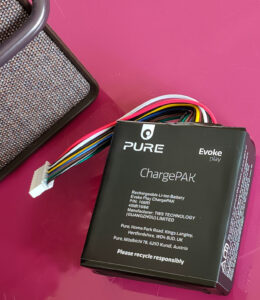
The battery specs are, however, there in full on the bottom of the battery itself. The pack seems to be a bundle of serially connected industry standard 18650 lithium ion units. These are slightly larger than the familiar AA size and each has a voltage of 3.7V.
The retail price for 18650s varies from around £7 to £15 each. As the pack is rated to deliver 14.4V, the bundle seems to comprise four of these units.
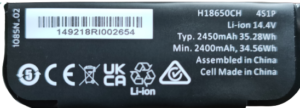
In the light of this, the £60 you’ll be paying to add the ChargePAK to your Evoke Play doesn’t sound too unreasonable. Particularly considering the board-mounted electronics (hence the flat upper side of the profile shown here) included to control the voltage and report on the capacity.
Installing the ChargePAK
This was slightly trickier than the accompanying instructions suggest. The two problems we encountered were:
-
- The supplied ChargePAK uses ten thick individual wires to connect to the radio. The illustration in the instructions shows a single thin ribbon cable.
- The orientation of the battery inside the radio’s narrow chamber has to be just right. The illustration in the instructions is accurate but not entirely clear. We fumbled here.
Bottom line: don’t just charge into installing the ChargePAK. And don’t rely on guesswork. We discovered subsequently that you can safely ignore the printed instructions as Pure is providing an excellent YouTube video showing how to do it.
The ChargePAK Up and Running
![]() With the ChargePAK installed, a small battery icon appears in the top left corner of the flip-up display screen to indicate the state of the charge. A percentage display would have been more useful. While charging, the icon is shown filling, emptying and refilling, the rate increasing as the charge grows. This makes judging by eye when the ChargePAK is fully charged a bit tricky. And the battery icon keeps jumping for some time once the radio is charged, a distraction Pure might consider fixing in a future firmware update. It’s easier to see when the battery is depleted—it displays an exclamation mark.
With the ChargePAK installed, a small battery icon appears in the top left corner of the flip-up display screen to indicate the state of the charge. A percentage display would have been more useful. While charging, the icon is shown filling, emptying and refilling, the rate increasing as the charge grows. This makes judging by eye when the ChargePAK is fully charged a bit tricky. And the battery icon keeps jumping for some time once the radio is charged, a distraction Pure might consider fixing in a future firmware update. It’s easier to see when the battery is depleted—it displays an exclamation mark.
In practice you’ll probably keep the Evoke Play plugged in for most of the time, so it will be fully charged whenever you want to travel with it.
All in All
This would suit a user of fixed habits. But disarming a daily alarm to give yourself a lie-in tomorrow morning, for example, takes you about ten key presses deep into the menu.
Without a top level method of changing the alarms, chances are you’ll just leave them alone.
It’s heartening to see Pure surging back to form with some fresh designs. The Pure Evoke Play is an elegant, well-judged compromise between audio quality and size and although not cheap would be a good choice for a kitchen or bedside* radio.
Most of the time we were putting this review together we were accompanied by the Pure Evoke playing one or other of our favourite Internet radio stations: Jazz 24, Bossa Jazz Brasil or Radio Alpha Fado (when it wasn’t tuned to the deeply saddening news coming out of Eastern Europe). The sound quality is truly room-filling, particularly when Jaco Pastorius is in the line-up.
But it wasn’t until the ChargePAK was installed, enabling the Pure Evoke Play to be carried from room to room that we heard this remarkable sound box at its best.
Looking back, this is a device that has played a large part in keeping us cheery through a somewhat dismal couple of months. None of the niggles we’ve mentioned here are showstoppers—we just want to give you the full picture.
The Pure Evoke Play is available from Amazon for 1p short of £250. The smaller Evoke Spot and the larger Evoke Home are a penny less than £180 and £400 respectively.
Chris Bidmead

